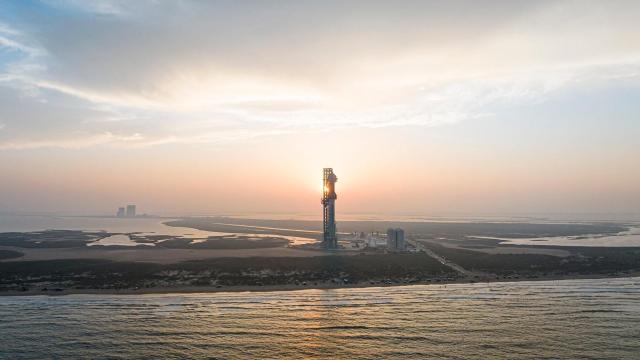The Federal Aviation Administration has completed the safety review of SpaceX’s Starship, moving the company one step closer to its second test flight, pending an environmental review by the U.S. Fish and Wildlife Service. The explosive inaugural launch of Starship turned into a safety and environmental fiasco—a situation that regulators and Elon Musk’s SpaceX are hoping to avoid the second time around.
We’re inching closer to the second flight of SpaceX’s megarocket. The Federal Aviation Administration announced on October 31 that it had completed the safety review portion of SpaceX’s Starship license evaluation, marking an important step forward for the aerospace company. This follows the completion of a comprehensive investigation into the chaotic debut launch of Starship on April 20, which resulted in a self-destruct sequence and dozens of mandated corrections for SpaceX.
In an emailed statement, the FAA highlighted that the public safety portion of the review is now complete. However, the regulator clarified that it is not yet in a position to issue a launch license, as there remains one final regulatory hurdle to overcome. The U.S. Fish and Wildlife Service is currently evaluating the new water deluge system installed at the Boca Chica launch mount, a review that began in earnest on October 19. This assessment, performed under the Endangered Species Act and in consultation with the FAA, could take anywhere from 30 to 135 days to complete. The FWS says it likely won’t need the full allotted time to complete the environmental review, which, if true, could result in Starship taking to the south Texas skies sooner rather than later.
The safety review “focused on issues that affect public health and safety of property,” the FAA explained in its statement. “It consists of evaluating the applicant’s safety organization, system safety processes, flight safety analysis, and quantitative risk criteria for launch, reentry, and vehicle disposal.”
The joint investigation between SpaceX and the FAA following the inaugural test flight, which ended with the rocket self-destructing over the Gulf of Mexico, identified a total of 63 corrective actions for SpaceX. Notably, 27 of these actions were related to public safety. By September 10, SpaceX reported that all of the identified corrective actions had been completed—corrective actions that, as the completed safety review makes clear, have met with the FAA’s approval.
Related: The Definitive Guide to SpaceX’s Starship Megarocket
Starship represents a significant advancement in SpaceX’s capabilities, with potential applications ranging from launching satellites to carrying humans on interplanetary missions. The Elon Musk-led company envisions Starship as playing a key role in future space exploration and colonisation and is a critical component of NASA’s Artemis program, which aims for sustainable lunar exploration.
Last week, in preparation for the second test flight, SpaceX successfully stacked a prototype Starship upper stage onto Booster 9 and conducted a wet dress rehearsal. The company has stated that the megarocket is now ready for its second flight, pending the launch license. SpaceX has voiced concerns about the speed at which the current regulatory process is moving. On October 18, company officials, along with representatives from Blue Origin and Virgin Galactic, vented to a Senate subcommittee, urging for a regulatory regime that is more in sync with the rapid advancements in space technology.
“We’ve entered an inflection point, with incredible innovation in commercial space launch. The criticality is especially true in the face of strategic competition from state actors like China,” said Bill Gerstenmaier, vice president of build and flight reliability at SpaceX, during the hearing. The company “is under contract with NASA to use Starship to land American astronauts on the moon before China does,” he added.
That the FAA needs to keep up with the times and grow in accordance with the space industry as a whole is clearly true, but SpaceX wants to have its cake and eat it, too; Musk is known for his opposition to higher taxes on wealthy individuals, yet boosting funding to government agencies could actually speed up SpaceX’s development projects.
SpaceX’s eagerness for a quick launch license is all fine and well, but the issues during the first Starship launch revealed the company’s tendency to prioritize ambition over safety (not that we didn’t know this from the explosive first batch of suborbital Starship tests performed from 2020 to 2021). This underscores the importance of comprehensive regulatory reviews, showing they are vital for accountability, and not merely annoying bureaucratic hoops.
